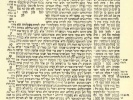
Sacred Texts Judaism Talmud Index Previous Next


Babylonian Talmud, Book 10: History of the Talmud, tr. by Michael L. Rodkinson, [1918], at sacred-texts.com
THE PERSECUTIONS OF THE TALMUD IN THE PERSIAN AND BYZANTINE EMPIRES IN THE SIXTH CENTURY AFTER THE CLOSE OF THE TALMUD.
In the reign of Kobad (Cabades) in Persia, a fanatic reformer named Mazdak desired to introduce the doctrine of the community of property and wives, thus modifying the Zoroastrian creed. (501). The king became an adherent of the new doctrine and decreed its acceptance by the people. The lower classes eagerly availed themselves of the license thus granted. To this communism, the Jews, led by Mar Zutra II., son of R. Huna, the young exilarch, offered an armed resistance. The occasion of the revolt was the murder of Mar Isaac, president of one of the colleges. It is related that they established an independent Jewish state, having for king the Prince of Captivity, with Machuza as the capital. At last, after seven years, Mar Zutra and his grandfather, Mar Chanina, were taken prisoners, executed, and their bodies nailed to the cross on the bridge of Machuza (about 520). On account of the ensuing persecutions the office of Exilarch remained for some time in abeyance. The colleges were closed, as the teachers were compelled to conceal themselves, and Abuna and Giza, two of the most, eminent, fled. When peace was restored after Kobad's death, the college at Sura, received Giza as president, and that at Pumbeditha, Semuna. A third name of eminence survives, that of Rabbi or Rab (near Nahardea), of whom little is known. Men of religious mind of the period devoted themselves to the study of the Talmud, the love for which persecution had but increased, which satisfied religious zeal and promoted tranquillity of mind, and the knowledge of which raised its possessor to positions of honor and trust.
The original development of the Talmud had at that period
ceased. Giza and Semuna conceived the desire to fix the laws for practical use, casting aside theoretical speculation, for it was necessary that there be no doubts or wavering. Their activity in this work was but a continuation of that which had begun at the close of the Talmud. The labors of the presidents of the colleges were confined to this task and to assembling, as of old, the disciples in Adar (March) and Ellul (September) and instructing them by lectures, and to assigning themes for private study. To fix the laws, the arguments pro and con needed to be weighed; therefore they were called Sabureans (Saburai). Many points of practice in the ritual, the civil law, and the marriage code were settled at this period.
Giza and Semuna gave chief attention to committing the Talmud to writing, making use of oral traditions and of notes made to aid the memory by various individuals. All legends were incorporated, and the obscure passages elucidated by their additions, for everything emanating from the Amoraim was thought important. In this form it has reached us. The vowel points to the Bible were also invented at this time, according to Graetz.
"The names of the immediate successors of Giza and Semuna have not been preserved either by chronicles or tradition"--forgotten in the persecution visited on the colleges during this century by both Christian and Zoroastrian churches.
Hormisdas IV., Chosroes Nushirvan's son, was unlike his father. Led by the Magi, who strove to check the approaching dissolution of their religion by persecution of the adherents of other faiths, he vented his wrath upon the Jews and Christians of his empire. The Talmudical colleges at Sura and Pumbeditha were closed, and again many teachers fled (about 581) this time to Firuzshabar, where, under an Arabian governor, they were less exposed to espionage. New colleges arose there, among which that of Mari was eminent, and there they continued their Talmudic labors. A general, Babram Tshubin, who had experienced the ingratitude of the king, usurped the Persian throne. In this he was assisted by the Jews with money and men, and in return granted them many favors and concessions. As a result, the colleges of Sura and Pumbeditha were reopened; Chanan of Iskia returned from Firuzshabar to Pumbeditha, and restored the college there; it is also probable
that the president of Sura, which was of far greater repute, was elected at that time, though his name is not mentioned in the chronicles.
With Babram's fall the vengeance of the lawful heir to the throne, prince Chosru, was visited on the Jews. With the aid of the Byzantine emperor, Mauritius, and the loyal portion of the Persian people, he defeated the usurper, putting to the sword also the greater part of the Jewish population of Machuza, and probably of other cities as well.